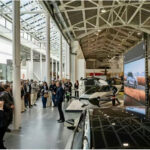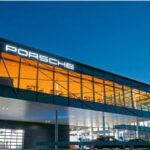The field of humanoid robots is experiencing a visible explosion at an unprecedented pace. According to analysis, since 2022, there have been 29 financing events in the humanoid robot field, with a disclosed total funding amount of 4.128 billion yuan.Recently, the Stanford Chinese team, “Versatile Household Robot” Mobile ALOHA, demonstrated the potential of robots in tasks requiring human intelligence, such as organizing, cooking, and laundry.
In 2022, Brett Adcock, known as the “next Elon Musk,” also founded a company called Figure, focusing on designing automatic general-purpose humanoid robots.
According to analysis, Figure was founded by Brett Adcock in January 2022. Since its establishment, it has raised a total of 790 million US dollars in two rounds. In April 2023, it secured a Series A financing of 70 million US dollars led by Parkway Venture Capital, with participation from FJ Labs, Moving Capital, Tamarack Global, BOLD Ventures, and Aliya Capital Partners. Three months later, it received an additional 9 million US dollars in Series A+ financing from Intel Capital.
Currently, Figure has 40 employees, including individuals from well-known companies such as Tesla, IHMC, Apple, and Cruise. They aim to create the world’s first commercially viable humanoid robot and integrate it into the human workforce.
Brett, who invested 10 million US dollars in the first round and an additional 20 million US dollars in the A round, mentioned that he might invest at least 100 million US dollars in Figure in the future. As a successful serial entrepreneur with over 20 years of experience, he believes that the deployment of humanoid robots for profitable business opportunities is less than five years away.
This optimism is fueled by the recent achievement of Figure 01 in learning to make coffee.
The Expected Delivery Date for Humanoid Robots is as Early as 2024
Humanoid robots have evolved through four stages since their inception in the 1970s: initial walking (Wabot at Waseda University), capability breakthrough (Honda humanoid robot), technological breakthrough (Boston Dynamics’ Atlas), and industrialization (Tesla’s Optimus).
Boston Dynamics, a representative company in technological breakthroughs, was established by MIT professor Marc Raibert in the 1990s with funding from the Defense Advanced Research Projects Agency (DARPA). In 2013, the company introduced the Atlas humanoid robot, agile and highly maneuverable, capable of even backflips. By 2018, their SpotMini robotic dog had achieved mass production with a base price of $74,500.
However, after Google acquired Boston Dynamics in 2013, concerns about the commercial viability of its various robots arose, leading to its sale to SoftBank, and it is currently under Hyundai’s control. Humanoid robots are still in the early stages globally, with no truly mature products available.
In recent years, with the surge of artificial intelligence, both capital and policies have once again converged on this industry. Figure aims to be the first artificial intelligence robot company to bring general-purpose robots into daily life. The designed humanoid robot is fully electromechanical, approximately 1.68 meters tall, weighs 60 kilograms, has an effective payload of 20 kilograms, is fully electric, and can operate for 5 hours after charging.
Brett’s attitude toward agile humanoid robots like Atlas is, “Existing humanoid robots are just stunts and demonstrations; we want to break away from this situation.” The company’s strategy is AI-first. “In extreme cases, we are like figures in the AI business, so we call ourselves Figure AI.”
Unlike controlled robots, humanoid robots are expected to have autonomy. Figure addresses this by building an AI-centric robot design capable of interacting with complex and unstructured real-world environments. With the help of large language models for semantic understanding of the world, an AI data engine is built internally for the robot to react.
“Accurately training the data generated by robots, deploying neural systems, the more robots we have in the market collecting data, the more applications the robot will learn.”
In March 2023, Figure completed the Alpha version, preparing for a significant update every six months. In November, Brett released a video of Figure’s first general-purpose humanoid robot, Figure 01, walking. From the video, it can be seen that the robot’s knees bend differently from human upright walking, and it even looks a bit comical.
TechCrunch comments pointed out that this bending is quite standard in humanoid robots, including Atlas and Digit, all having similar knee structures to maintain balance.
The product still maintains a sense of mystery, but many people are curious. Under Brett Adcock’s Figure promotional video, a netizen jokingly commented, “Considering Tesla’s robot is named Optimus (Prime), yours should be called Megatron.”
The showdown between these two robots cleverly unfolded.
As early as October 2022, Musk introduced the prototype of the Tesla humanoid robot Optimus, capable of carrying boxes, doing odd jobs, watering, and was expected to cost less than $20,000 per unit. However, this robot still couldn’t walk properly. This is when Figure was founded in less than half a year.
In the second half of Figure 01’s walking video release month, Musk unveiled Optimus Gen 2, demonstrating a 112-pound robot using more flexible fingers to cook eggs, walk, and dance. Netizens mocked, “Elon Musk, who fears artificial intelligence, is designing completely autonomous robots.”
Following that, on January 7th, Figure released a new video, announcing a significant technological breakthrough for Figure 01. It can learn the process of making coffee by watching human demonstration videos. Brett stated that Figure uses an end-to-end artificial intelligence system to analyze and process video data through neural networks.

Brett mentioned that Figure would require billions of dollars in investment and engineering innovation to make a significant impact on the mass market. The pilot project with 50 robots is expected to be conducted in a real warehouse environment in 2024, and the earliest delivery time for humanoid robots to customers is also in 2024.
The “Next Musk” Likes to Go All-In
Figure’s DNA is half autonomous vehicles and half robot arms. This statement comes from the fact that Brett recruited talent from well-known companies such as Boston Dynamics and Tesla, combining experts in various fields such as robotics, sensors, perception, and navigation.
The influx of talent and funding is not unrelated to Brett Adcock’s personal influence. With nearly 20 years of entrepreneurship experience in the tech industry, he has been dubbed the “next Elon Musk” by the media. In September of the previous year, in the “My First Million” program, host Sam Parr labeled Brett as “Elon Musk 2.0” on the video cover, indicating a net worth of 3 billion US dollars and stating that he would become a figure like Howard Hughes or Elon Musk within 10 years.
Brett is a fan of Musk, and the two indeed share similarities. Both started from scratch, self-taught, and established their first companies at the age of fifteen or sixteen. In their early twenties, they achieved complete financial freedom. Brett has a track record of selling a recruitment company for $110 million and successfully ringing the bell for an eVTOL company valued at $2.7 billion. Now he believes, “We are less than 5 years away from deploying humanoid robots for profitable business opportunities.”
In 2002, while Musk invested $100 million to establish SpaceX, Brett, at the age of 16, also founded his first tech company. After graduating from the University of Florida, Brett founded StreetofWalls.com and Working.io as content platforms, officially starting his journey into tech entrepreneurship.
StreetofWalls.com still exists today and has attracted over 30 million views.
At the age of 26, Brett founded Vettery, an AI-based online talent marketplace that reportedly matched 20,000 interviews per month at the time. In an interview, Brett recalled that no one invested in Vettery in the first year, so he invested his savings for three consecutive years. There are rumors that for Vettery, Brett once invested his last dollar and had to borrow to pay rent in 2015. By 2017, Brett had raised $12 million in venture capital from Greycroft Investors, Raine Ventures, and Pritzker Venture Capital, and Vettery was named the best workplace in New York City in 2016 and 2017 by Crain’s magazine.
In 2018, after six years of operation, Vettery was acquired by the Adecco Group for $110 million. Brett expressed his sentiments, stating, “It was significant, going from 7 years of pain and debt to having capital overnight.”
In October of the same year, Brett founded Archer Aviation. Archer initially received research funding from the University of Florida and was an eVTOL (electric vertical takeoff and landing) company for urban air transport, aiming to transform cities’ sustainable transportation. In simple terms, they wanted to commercialize “flying taxis.” Brett’s idea was straightforward, “If we know we can fly 15 miles safely and affordably within 7 minutes, many people will accept this service.”

Peter H. Diamandis, co-founder of Bold Ventures, who has known Musk for nearly 24 years, commented on Brett’s determination to build Archer, comparing it to Musk’s early days at SpaceX. Brett searched for textbooks, read a lot of books, interviewed people, learned knowledge, and then began construction.
Initially, knowing nothing about aviation hardware after 15 years of software services, Brett was well aware that in the short term, the possibility of learning the entire process from designing to manufacturing an aircraft was close to zero. “So the first thing I did was create a spreadsheet, call everyone I could think of in the world, whether they were NASA personnel or professors, rotorcraft and turbofan workers.” Thus, Brett, alone in a room, made 300 phone calls with a single phone over six months.
In addition, he took mechanical and aerospace engineering courses, and at the Sierra Lab on Archer Road, he began building small electric aircraft, which was the origin of the name Archer. According to Brett, he later built a 4,000-square-foot lab at the University of Florida, where he and a group of PhD students built the third and fourth generations of eVTOL, designed, tested, and flew the fifth generation eVTOL, and vertically integrated aircraft design, flight software, drivetrain, electric motor, and battery systems.
Brett joked, “We basically need about $1 billion, maybe more to enter the market.” This time, he also went “all in” by selling all of Vettery’s funds for Archer, almost personal bankruptcy, which was considered an irrational investment move by others. Does this “crazy person” not understand finance? Not so, Brett self-studied finance courses, and on his StreetofWalls.com website, he displayed a series of articles from investment banking to cash flow analysis, based on his study notes, and did a lot of IPO preparation work. Brett said, “I think doing better things at the right time is right for me, but this is definitely not the right approach.”
In September 2021, he fulfilled his promise. According to the official website, Brett raised over $1 billion, Archer went public on the NYSE with a valuation of $27 billion, and signed a $1.5 billion commercial agreement with United Airlines, having a positive impact in the tech industry. Imagination turned into reality, and in November 2023, Archer conducted flight tests of the finished product Midnight.
According to an article by MoneyINC, in February 2021, when Archer’s valuation approached $6 billion, Brett Adcock’s net worth was estimated to exceed $1 billion.
Warehousing Humanoid Robots
In May 2022, Brett announced his resignation from the Archer board and founded Figure. He wrote on the official website, “Figure, with a vision for the next 30 years.”
Brett entered large warehouses, retail storage, and automotive groups, seeing that the world is facing a labor crisis, aggravated by an aging population, with over 10 million dangerous/unwanted jobs in the United States alone. Therefore, humans need higher productivity, and robots have a vast market.
To make the bipedal robot system powerful and commercially viable, he chose an electric execution system that is stronger and more efficient, safe, and efficient than Boston Dynamics’ hydraulic operation. Moreover, Figure is building different types of vision language models to showcase the robot’s autonomous capabilities.
Compared to the approximately 10,000 parts of a Tesla Model 3, Figure has about 1,000 parts per robot. In the long run, the cost of a humanoid robot is expected to be lower than that of a cheap electric car. According to the Experience Curve, as manufacturing volume increases, the cost may decrease by 20% or 30%. The final price of robots has the potential to drop below $30,000, cheaper than hiring a human for a year. Moreover, in addition to the purchase model, Figure believes that the healthier business model for humanoid robots in the future is the leasing model, “which is a way to reduce the upfront burden and means we can constantly renovate software and hardware to make robots better.”
Brett believes that within five years, robots will be deployed in commercial applications for some of the world’s largest brands, creating a potential industry value of tens of billions of dollars. The business value of humanoid robots may even exceed that of companies with valuations exceeding $30 billion, such as Cruise and Waymo.
Currently, Figure has produced five prototypes of humanoid robots. The goal is to apply the product in the warehouse and manufacturing sector facing a shortage of labor. “Hardware companies need time,” Brett said, “we need 20 or 30 years to truly achieve this goal.”
“From a financing perspective, this is not the ideal market for Series A; it’s the worst market since the financial crisis,” Brett said. However, he still chose his preferred “All in” approach, investing the majority of funds into Figure in the first year.

This time, Brett has ventured into a new field that combines both hardware and software, where there are no ready-made hardware solutions or mature commercial software solutions. Figure needs to design its own robot actuators, batteries, electronic devices, structures, and sensors, building a complete robot from scratch.
He borrowed a saying to describe Figure’s upcoming actions: “The only way out is through.”
“Figure, I use it as the next course of study,” he connected the logic of several companies, building significant traffic to StreetofWalls.com’s website, using it to guide and establish Vettery’s market, and then leveraging Vettery’s network to launch Archer, “and Archer is one of our largest investors.”
Brett mentioned in a podcast that when he left Archer in April 2022, he had a 12-month stock lock-up period, unable to sell. “In 2022, I was basically bankrupt. When I left, my money was all tied up in Archer.”
For Figure, Brett spends millions every month, or even more, to build the team and purchase hardware. The bad news is that in September 2023, Brett said their cash flow is almost depleted. The good news is that their Figure 01 has learned to make coffee by watching human demonstration videos.













Leave a comment